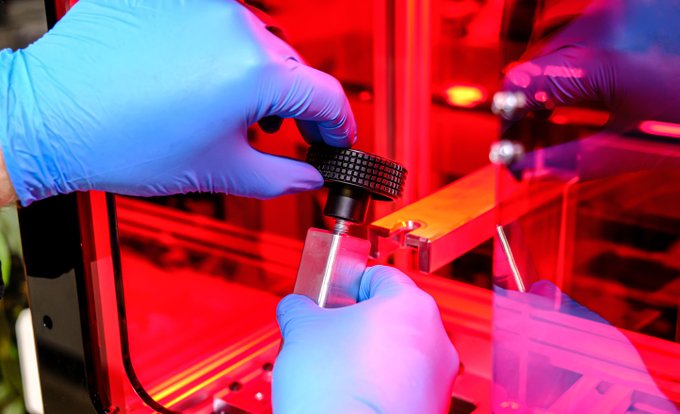3D printer and materials manufacturer Photocentric has announced the launch of a new division that’s dedicated to the development of eco-friendly 3D printed electric batteries.
The Peterborough-based firm has committed a “significant investment,” which includes its entire research team, to designing more energy-efficient storage devices. Having previously led several other grant-funded projects, the company is now stepping up its efforts and dedicating further resources to optimizing 3D printed fuel cells for automotive applications.
According to Dr Sarah Karmel, Head of R&D Chemistry at Photocentric, by utilizing its patented 3D printing technology, the firm could develop custom-made car batteries with enhanced storage capabilities. “Currently, electric vehicles are made to fit around the battery module” she explained. “We want to create customised batteries that fit the vehicle”.
Photocentric’s broad product portfolio
Established in 2002, Photocentric is known as a producer of photopolymer resins, and for its patented Visible Light Polymerization (VLP) 3D printing technology. The company’s technique uses a low energy light source to polymerize liquid resins, as opposed to high-intensity UV laser or a light projector-based printing methods.
The firm’s range of LCD systems include the Liquid Crystal and LC Maximus, which address applications in the industrial sector as well as the dental and figurine industries. Launched in 2015, Photocentric’s low-cost Liquid Crystal represented its first foray into the printer manufacturing market.
Featuring the firm’s proprietary Daylight Printing Process (DPP) technology, the desktop system had a print volume of 200 x 100 x 200 mm, enabling a layer resolution of 25 microns. Photocentric’s newer LC Maximus machine is more geared towards mass-production and large-scale prototyping. The Maximus also uses DPP technology, but features a larger 4K 40” screen and 700 x 893 x 510mm build size, allowing more parts to be printed at once.
More recently, the company has expanded the medical applications of its technology by transforming its headquarters into a PPE print farm, in order to help in the fight against COVID-19. In a contract awarded by the UK government, the firm will manufacture over 7.6 million 3D printed protective face shields over the next six months.
Now, through its new battery development division, Photocentric is aiming to further utilize its LCD 3D printers to fabricate more eco-friendly car-specific fuel cells.

Photocentric’s new battery research division
Photocentric has long considered the development of improved energy storage devices to be one of the most important environmental issues in the world. The company has led numerous research programs in recent years to this effect, and attempted to integrate its 3D printing technologies into the battery production process.
Using grants funded by the Advanced Propulsion Centre, Photocentric is currently contributing to the Technology Developer Programme (TDAP). The research project has seen the firm collaborate with the Centre for Process Innovation (CPI), Innovate UK and sustainable tech business Johnson Matthey, to 3D print solid state batteries.
Building on this research, Photocentric is now ramping up its development plans for its own additive manufactured fuel cells. In what the company is referring to as “the biggest research project in its history,” it’s seeking to leverage its VLP technology to enable the low-cost mass manufacture of car batteries.
Current battery cells are large, heavy and not optimized for automotive use, meaning that vehicle design is often dictated by availability rather than suitability. Utilizing its existing fleet of systems, Photocentric intends to 3D print battery electrodes that are lighter and smaller, and better suited than existing devices.
The company hopes that the fast-charging and increased power density capabilities of its future batteries will lead to their adoption within Tesla’s upcoming UK-based Giga factory. In order to achieve its lofty end-use ambitions, Photocentric has already started to expand its team of scientists, and will put them straight to work on its next-generation 3D printed fuel cells.
The eco-friendly credentials of 3D printing
Additive manufacturing is often marketed as a more sustainable and efficient form of production than traditional industrial methods. In order to make 3D printing even more eco-friendly, numerous researchers have attempted to develop different recyclable printing materials in recent years.
Researchers from Harvard University have developed a keratin-based 3D printing polymer that can be made using recycled clothing from the textiles industry. The novel filament can also be pre-programmed with reversible shape memory capabilities.
Scientists from the University of Freiburg have combined lignen with cellulose to produce a wood-based biosynthetic polymer for additive manufacturing. The sustainable new printing material could be used within the light construction or industrial sectors.
A team from Oak Ridge National Laboratory (ORNL) have developed a novel 3D printed device that’s capable of increasing the amount of carbon captured from burning fossil fuels. Leveraging additive manufacturing, the researchers were able to combine a heat exchanger and a mass-exchanging contactor into a more efficient multi-functional unit.
Nominations for the 2020 3D Printing Industry Awards are still open, let us know who is leading the industry now.
The fourth edition of the 3D Printing Industry Awards Trophy Design Competition is now underway. Enter your design for the chance to win a CraftBot Flow 3D printer.
To stay up to date with the latest 3D printing news, don’t forget to subscribe to the 3D Printing Industry newsletter or follow us on Twitter or liking our page on Facebook.
Are you looking for a job in the additive manufacturing industry? Visit 3D Printing Jobs for a selection of roles in the industry.
Featured image shows a researcher experimenting with a Photocentric 3D printer. Image via Photocentric.


